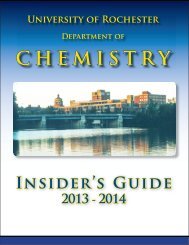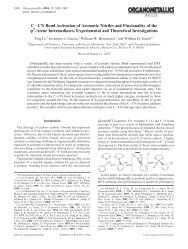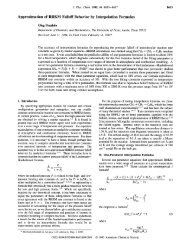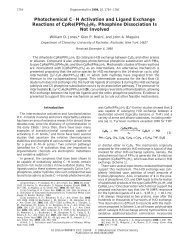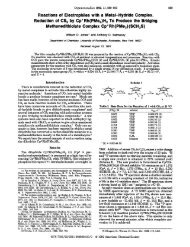Isotope Effects in C-H Bond Activation Reactions by Transition Metals
Isotope Effects in C-H Bond Activation Reactions by Transition Metals
Isotope Effects in C-H Bond Activation Reactions by Transition Metals
Create successful ePaper yourself
Turn your PDF publications into a flip-book with our unique Google optimized e-Paper software.
<strong>Isotope</strong> <strong>Effects</strong> <strong>in</strong> C-H <strong>Bond</strong> <strong>Activation</strong><br />
Jones<br />
Scheme 5<br />
observe the rate at which the σ-alkane complex converts<br />
to the alkyl hydride or deuteride product.<br />
This measurement would prove difficult, however,<br />
because it would require observ<strong>in</strong>g the coord<strong>in</strong>atively<br />
unsaturated <strong>in</strong>termediate [Tp*Rh(CNR)] and monitor<strong>in</strong>g<br />
its rate of disappearance <strong>in</strong> deuterio- or protioalkane.<br />
Instead, we chose to generate the [Tp*Rh(CNR)] fragment<br />
<strong>in</strong> the presence of CH 2 D 2 . Rapid coord<strong>in</strong>ation of the<br />
hydrocarbon would generate the σ-methane complex of<br />
CH 2 D 2 , which conta<strong>in</strong>s equal numbers of C-H and C-D<br />
bonds; we could then monitor the k<strong>in</strong>etic selectivity for<br />
formation of Tp*Rh(CNR)(CHD 2 )H vs Tp*Rh(CNR)(CH 2 D)D.<br />
This was accomplished <strong>by</strong> irradiation of the precursor<br />
complex Tp*Rh(CNR)(RNdCdNPh) <strong>in</strong> the <strong>in</strong>ert solvent<br />
C 6 F 6 under 10 atm CH 2 D 2 at low temperature. 15 The ratio<br />
of the k<strong>in</strong>etically formed products was 4.3:1, and over time<br />
at 10 °C the ratio was seen to adjust to ∼1.7:1 (eq 4). Based<br />
upon the <strong>in</strong>itial ratio, the k<strong>in</strong>etic isotope effect for oxidative<br />
cleavage is therefore k OCH /k OCD ) 4.3...a normal<br />
isotope effect, but larger than that seen <strong>in</strong> the reductive<br />
coupl<strong>in</strong>g. Consequently, <strong>in</strong> this system <strong>in</strong>volv<strong>in</strong>g the<br />
activation of alkanes <strong>by</strong> the [Tp*Rh(CNR)] fragment, it is<br />
clearly determ<strong>in</strong>ed that the situation depicted <strong>in</strong> Scheme<br />
3b applies, and the the <strong>in</strong>verse equilibrium isotope effect<br />
arises as a result of two normal isotope effects of different<br />
magnitudes that oppose each other.<br />
Furthermore, one calculates an equilibrium isotope<br />
effect of 2.1/4.3 ) 0.49 from eq 3. This compares reasonably<br />
well with the observed value of 1/1.7 ) 0.59 from<br />
the equilibration seen <strong>in</strong> eq 4. Also, the reductive coupl<strong>in</strong>g<br />
isotope effect (k RCH /k RCD ) was determ<strong>in</strong>ed for the isopropyl<br />
hydride complex, but it is reasonable to expect a similar<br />
isotope effect with the methyl hydride complex.<br />
In a separate exam<strong>in</strong>ation of the above isotope effects,<br />
the complex Tp*Rh(CNR)(CH 3 )D was synthesized and<br />
allowed to equilibrate with Tp*Rh(CNR)(CH 2 D)H, similar<br />
to other cases that have been reported <strong>in</strong> the literature.<br />
Scheme 5 summarizes the k<strong>in</strong>etics for the complex, and<br />
FIGURE 2. Scrambl<strong>in</strong>g of deuterium <strong>in</strong> Tp*Rh(CNR)(CH 3 )D at 26 °C.<br />
Figure 2 shows the distribution of species. From the figure,<br />
one can see that the methyl deuteride and methyl-d 1<br />
hydride complexes are nearly equilibrated after about half<br />
of the methane has been lost, and that K eq ≈ 6.3. In this<br />
example, the complex Tp*Rh(CNR)(CH 2 D)H would be<br />
favored statistically <strong>by</strong> a factor of 3 over Tp*Rh(CNR)-<br />
(CH 3 )D. In addition, there should be an equilibrium<br />
isotope effect of 2.05 () (k OCH /k OCD )/(k RCH /k RCD ) ) 4.3/2.1).<br />
With the comb<strong>in</strong>ation of these two effects, one expects<br />
an equilibrium ratio of these two complexes of about 6.1:<br />
1. The excellent agreement <strong>in</strong> this <strong>in</strong>dependent experiment<br />
<strong>in</strong>dicates that the assumptions made about the<br />
isotope effects transfer reasonably well from one Tp*Rh-<br />
(CNR)(alkyl)H complex to another.<br />
In addition, it was possible to simulate <strong>in</strong> detail the<br />
microscopic k<strong>in</strong>etics of the Tp*Rh(CNR)(CH 3 )D system,<br />
as described previously <strong>in</strong> detail. 15 The data treatment<br />
allowed the determ<strong>in</strong>ation of relative rate constants <strong>in</strong> this<br />
system, but not absolute rate constants for any reaction<br />
stemm<strong>in</strong>g from the σ-methane complex (s<strong>in</strong>ce no σ-methane<br />
complex is directly observed). The fitted rate constants<br />
provide a value for the oxidative bond formation isotope<br />
effect, k OCH /k OCD , of 4.8, compared with the direct observation<br />
of 4.3 from eq 4. Aga<strong>in</strong>, good agreement is seen.<br />
The fitted rate constants also give a value for K eq of 7.1,<br />
compar<strong>in</strong>g well with the observed value of 6.3 toward the<br />
end of the reaction <strong>in</strong> Figure 2.<br />
4. <strong>Isotope</strong> <strong>Effects</strong> <strong>in</strong> Arene <strong>Activation</strong> <strong>by</strong><br />
[Cp*Rh(PMe 3 )]<br />
Just as H/D scrambl<strong>in</strong>g has been taken as evidence for<br />
the <strong>in</strong>termediacy of σ-alkane complexes, H/D scrambl<strong>in</strong>g<br />
<strong>in</strong> aryl deuteride complexes has been taken as provid<strong>in</strong>g<br />
evidence for η 2 -arene complexes (eq 5). The η 2 -benzene<br />
complex can be seen <strong>in</strong> transient absorption experiments,<br />
and with naphthalene, the equilibrium is such that both<br />
η 2 -arene and aryl hydride complex can be directly ob-<br />
VOL. 36, NO. 2, 2003 / ACCOUNTS OF CHEMICAL RESEARCH 143




